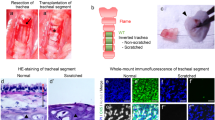Summary
All stages of epithelial regeneration following a focal denuding mechanical injury have been quantified in hamster trachea. The epithelium was divided into wound and non-wound sites and every cell around the entire tracheal circumference was counted and catergorized according to cell type. The control hamster tracheal epithelium was composed of about 33% ciliated cells, 57% secretory cells and 10% basal cells. Proliferative activity, measured as mitotic rate (MR) following a 6 h colchicine metaphase blockade, was low and confined to the secretory and basal cells. The total cell population had a MR of 0.12% (0.08% secretory cells; 0.04% basal cells).
Following a focal denuding wound in the ventral portion of the epithelium, 18% of all the epithelial cells were lost by 6 h. This loss increased to 31% by 12 h. Secretory cells and basal cells from the adjacent non-wounded epithelium flattened into a squamous morphology and during the first 12 h migrated into the wound at about 0.5 μ per min to cover the defect. Cell division at the wound was low at 12 h (MR = 0.4%), but by 24 h an exponential increase in cell proliferation had occured in the wound site (MR = 31.1%). Secretory cells (MR = 19.9%), basal cells (MR = 1.4%) and squamous cells-a mixture of flattened secretory and basal cells (MR = 9.8%)-contributed to this proliferative activity. Mitotic activity in the non-wounded epithelium remained low (MR= 0.6%).
Cell proliferation at the wound site produced a multilayered epidermoid metaplastic epithelium by 36 and 48 h. Mitotic activity remained high at these times (36 h MR = 21%, 48 h MR = 12%). Thereafter (60 h–120 h) mitotic activity fell to near control levels, and the wound epithelium was gradually replaced by recognizable basal, secretory and preciliated cells. The latter, first seen in the wound at 48 h, and recognized as very large pale non-ciliated cells, developed cilia through 60, 72, and 96 h so that a nearly normal epithelium was restored by 120 h.
Similar content being viewed by others
References
Adamson IYR, Bowden DH (1974) The type 2 cell as progenitor of alveolar epithelial regeneration: A cytodynamic study in mice after exposure to oxygen. Lab Invest 30:35–42
Bang FB, Bang BG (1977) Mucous membrane injury and repair. In: Brain JD, Proctor DF, Reid LM (eds) Respiratory defense mechanisms, part I. Marcel Dekker, New York, pp 453–488
Bang FB, Foard M, Bang BG (1974) Acute Newcastle viral infection of the upper respiratory tract of the chicken I. A model for the study of environmental factors on upper respiratory tract infection. Am J Pathol 76:333–348
Becci PJ, McDowell EM, Trump BF (1978a) The respiratory epithelium II. Hamster trachea, bronchus and bronchioles. J Natl Cancer Inst 61:551–561
Becci PJ, McDowell EM, Trump BF (1978b) The respiratory epithelium IV. Histogenesis of epidermoid metaplasia and carcinomain situ in the hamster. J Natl Cancer Inst 61:577–586
Bils RF, Christie BR (1980) The experimental pathology of oxidant and air pollutant inhalation. Int Rev Exp Pathol 21:195–293
Bindreiter M, Schuppler J, Stockinger L (1968) Zeilproliferation und Differenzierung im Trachealepithel der Ratte. Exp Cell Res 50:377–382
Boren HG, Paradise LJ (1978) Cytokinetics of lung. In: Harris CC (ed) Pathogenesis and therapy of lung cancer. Marcel Dekker, New York, pp 369–418
Boren HG, Pauley J, Wright EC, Kaufman DG, Smith JM, Harris CC (1974) Cell populations in the hamster tracheal epithelium in relation to vitamin A status. Int J Vit Nutr Res 44:383–390
Castleman WL, Dungworth DL, Schwartz LW, Tyler WS (1980) Acute respiratory bronchiolitis. An ultrastructural and autoradiographic study of epithelial cell injury and renewal in Rhesus monkeys exposed to ozone. Am J Pathol 98:811–840
Chakrin LW, Saunders LZ (1974) Experimental chronic bronchitis. Pathology in the dog. Lab Invest 30:145–154
Clyde WA (1980) Experimental models for study of common respiratory viruses. Envir Health Persp 35:107–112
Condon WB (1942) Regeneration of tracheal and bronchial epithelium. J Thorac Surg 11:333–346
Correll NO, Beattie EH (1956) The characteristics of regeneration of respiratory epithelium. Surg Gynecol Obstet 103:209–211
Cuppage FE, Chiga M, Tate A (1972) Cell cycle studies in the regenerating rat nephron following injury with mercuric chloride. Lab Invest 26:122–126
Dahlgren SE, Dalen H, Dalhamn T (1972) Ultrastructural observations on chemically inducted inflammation in guinea pig trachea. Virchows Arch [Zell Pathol] 11:211–223
Dipasquale A (1975a) Locomotory activity of epithelial cells in culture. Exp Cell Res 94:191–215
Dipasquale A (1975 b) Locomotion of epithelial cells. Factor involved in extension of the leading edge. Exp Cell Res 95:425–439
Evans MJ, Johnson LV, Stephens RJ, Freeman G (1976) Renewal of the terminal bronchiolar epithelium in the rat following exposure to NO2 or O3. Lab Invest 35:246–257
Francis T, Stuart-Harris CH (1938) Studies on the nasal histology of epidemic influenza virus infection in the ferret. I. The development and repair of the nasal lesion. J Exp Med 68:789–802
Fleischmann W, Russel O, Fleischmann S (1962) LD 50 and minimal effective anti-mitotic dose of colchicine in various rodents. Med Exp 6:101–104
Gordon RE, Lane BP (1976) Regeneration of rat tracheal epithelium after mechanical injury. II. Restoration of surface integrity during the early hours after injury. Am Rev Resp Dis 113:799–807
Gordon RE, Lane BP (1977) Cytokinetics of rat tracheal epithelium stimulated by mechanical trauma. Cell Tissue Kinet 10:171–181
Gordon RE, Lane BP (1980) Wound repair in rat tracheal epithelium. Division of G1 and G2 arrested cells following injury. Lab Invest 42:616–621
Greenburg SD, Willms RK (1962) Regeneration of respiratory epithelium. An experimental study in dogs. Arch Pathol 73:67–70
Harris CC, Kaufman DG, Sporn MB, Smith JM, Jackson F, Saffiotti U (1973a) Ultrastructural effects of N-methyl-N-nitrosourea on the tracheobronchial epithelium of the Syrian golden hamster. Int J Cancer 12:259–269
Harris CC, Silverman T, Smith JM, Jackson E, Boren HG (1973b) Proliferation of tracheal epithelial cells in normal and vitamin A deficient Syrian golden hamsters. J Natl Cancer Inst 51:1059–1062
Harris CC, Frank A, Barrett LA, McDowell EM, Trump BF, Paradise LJ, Boren H (1975) Cytokinetics in the respiratory epithelium of the hamster, cow and man. J Cell Biol 67:158a
Hattum AH, James J, Klopper PJ, Muller JH (1979) A model for the study of epithelial migration in wound healing. Virchows Arch [Cell Pathol] 30:221–230
Hilding AC (1965) Regeneration of respiratory epithelium after minimal surface trauma. Ann Otol Rhinol Laryngol 74:903–914
Hilding DA, Hilding AC (1966) Ultrastructure of tracheal cilia and cells during regeneration. Ann Otol Rhinol Laryngol 75:281–294
Jeffery PK, Reid LM (1981) The effect of tobacco smoke, with or without phenylmethyloxadiazole (PMO), on rat bronchial epithelium: A light and electron microscopic study. J Pathol 133:341–359
Kauffman SL (1980) Cell proliferation in the mammalian lung. Int Rev Exp Pathol 22:131–191
Kaufman DG, Baker MS, Harris CC, Smith JM, Boren H, Sporn MB, Saffiotti U (1972) Coordinated biochemical and morphologic examination of hamster tracheal epithelium. J Natl Cancer Inst 49:784–792
Keenan KP, Combs JW, McDowell EM (1982b) Regeneration of hamster tracheal epithelium after mechanical injury. II. Multifocal lesions: Stathmokinetic and autoradiographic studies of cell proliferation. Virchows Arch [Cell Pathol] 41:215–229
Keenan KP, Combs JW, McDowell EM (1982c) Regeneration of hamster tracheal epithelium after mechanical injury. III. Large and small lesions: Comparative stathmokinetic and single pulse and continuous thymidine labeling autoradiographic studies. Virchows Arch [Cell Pathol] 41:231–252
Keenan KP, Wilson TS, McDowell EM (1982d) Regeneration of hamster tracheal epithelium after mechanical injury. IV. Histochemical, immunocytochemical and ultrastructural studies. Submitted to Virchows Arch [Cell Pathol]
Kennedy AR, Desrosiers A, Terzaghi M, Little JB (1978) Morphometric and histological analysis of the lungs of Syrian golden hamsters. J Anat 125:527–553
Lamb D, Reid L (1968) Mitotic rates, goblet cell increase and histochemical changes in mucus in rat bronchial epithelium during exposure to sulphur dioxide. J Pathol Bact 96:97–111
Lane BP, Gordon R (1974) Regeneration of rat tracheal epithelium after mechanical injury. I. The relationship between mitotic activity and cellular differentiation. Proc Soc Exp Biol Med 145:1139–1144
Luna LG (1968) Manual of histologic staining methods of the Armed Forces Institute of Pathology. McGraw-Hill, New York
Marin ML, Gordon RE, Lane BP (1979) Development of tight junctions in rat tracheal epithelium during the early hours after mechanical injury. Am Rev Resp Dis 119:101–106
McDowell EM, Barrett LA, Glavin F, Harris CC, Trump BF (1978) The respiratory epithelium. I. Human bronchus. J Natl Cancer Inst 53:539–549
McDowell EM, Becci PJ, Schürch W, Trump BF (1979) The respiratory epithelium. VII. Epidermoid metaplasia of hamster tracheal epithelium during regeneration following mechanical injury. J Natl Cancer Inst 62:995–1008
McDowell EM, Combs JW, Newkirk C (1982a) A quantitative light and electron microscopic study of hamster tracheal epithelium with special attention to so-called “intermediate cells.” Exp Lung Res (in press)
McDowell EM, Combs JW, Newkirk C (1982b) Acute changes in secretory cells of lower tracheal epithelium of hamsters in response to sub-lethal injury: A quantitative study. Exp Lung Res (in press)
Mohr U, Ketkar MB (1980) Animal model. Spontaneous carcinoma of the lung in hamsters. Am J Pathol 99:521–524
Montesano R, Saffiotti U, Shubik P (1970) The role of topical and systemic factors in experimental respiratory carcinogenesis. In: Hanna MG, Nettesheim P, Gilbert JR (eds) Inhalation carcinogenesis. AEC Symposium Series 18:353–371
Nettesheim P (1972) Respiratory carcinogenesis with the Syrian golden hamster: A review. Prog Exp Tumor Res 16:185–200
Port CD, Baxter DW, Harris CC (1974) Surface morphology of tracheal epithelium in vitamin A deficiency and reversal. In: Karbe E, Park JF (eds) Experimental lung cancer, carcinogenesis and bioassays. Springer, Berlin Heidelberg New York, pp 256–264
Ruddell CL (1967) Epoxy media for 1–2 micron sectioning. Stain Tech 42:253–255
Scarpelli DG, Rao S, Subbarao V, Beversluis M (1981) Regeneration of Syrian golden hamster pancreas and covalent binding of N-nitroso-2,6[3H]dimethylmorpholine. Cancer Res 41:1051–1057
Simpson GEC, Finckh ES (1963) The pattern of regeneration of rat liver after repeated partial hepatectomies. J Pathol Bacteriol 86:361–370
Sorokin SP, Hoyt RF (1978) PAS-lead hematoxylin as a stain for smallgranule endocrine cell populations in the lungs, other pharyngeal derivatives and the gut. Anat Rec 192:245–259
Spicer SS, Chakrin LW, Wardell JR (1974) Effect of chronic sulfur dioxide inhalation on the carbohydrate histochemistry and histology of the canine respiratory tract. Am Rev Resp Dis 110:13–24
Stockinger L (1964) Beiträge zur Entwicklung und Ultrastruktur des Flimmersaumes. Verh Anat Ges 59:43–52
Townsend SF (1961) Regeneration of gastric mucosa in rats. Am J Anat 109:133–141
Wells AB (1970) The kinetics of cell proliferation in the tracheobronchial epithelia of rats with and without chronic respiratory disease. Cell Tissue Kinet 3:185–206
Wilhelm DL (1953) Regeneration of tracheal epithelium. J Pathol Bact 65:543–550
Wong YC, Buck RC (1971) An electron microscopic study of metaplasia of the rat tracheal epithelium in vitamin A deficiency. Lab Invest 24:55–66
Author information
Authors and Affiliations
Additional information
The opinions and assertions contained herein are the private views of the authors and are not to be construed as official or as reflecting the views of the Department of Defense. The experiments reported herein were conducted according to the principles set forth in the “ Guide for the Care and Use of Laboratory Animals”, Institute of Laboratory Animal Resources, National Research Council, DHEW Publ. No. 78-23. This is contribution No. 1265 from the Cellular Pathobiology Laboratory, Department of Pathology, University of Maryland School of Medicine
This work was supported in part by USPHS NIH Grant HL≠ 24722
Submitted by K.P.K. in partial fulfillment of a Doctor of Philosophy degree from the Department of Pathology, University of Maryland School of Medicine
Rights and permissions
About this article
Cite this article
Keenan, K.P., Combs, J.W. & McDowell, E.M. Regeneration of hamster tracheal epithelium after mechanical injury. Virchows Archiv B Cell Pathol 41, 193–214 (1982). https://doi.org/10.1007/BF02890281
Received:
Accepted:
Published:
Issue Date:
DOI: https://doi.org/10.1007/BF02890281




